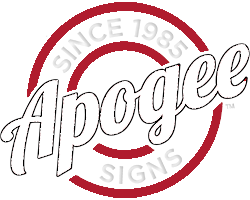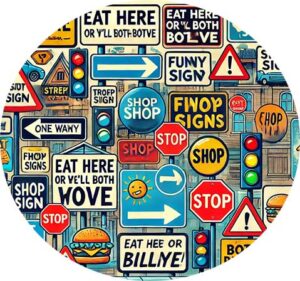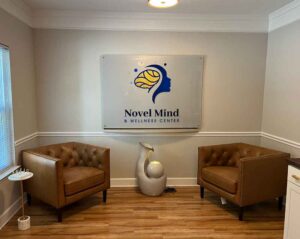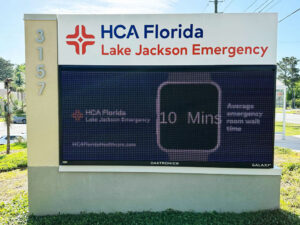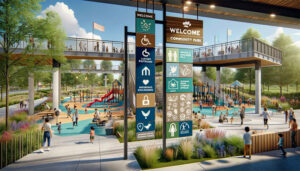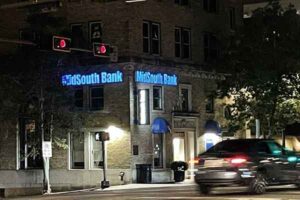 Illuminated or lighted signage refers to the signs that are designed to complement and enhance the overall architecture of a building. When designing lighted signs, it is important to consider factors such as the building’s architecture, location, and surrounding environment.
Illuminated or lighted signage refers to the signs that are designed to complement and enhance the overall architecture of a building. When designing lighted signs, it is important to consider factors such as the building’s architecture, location, and surrounding environment.
Working with a professional sign company such as Apogee Signs can help ensure that your lighted signage is aesthetically pleasing, effective, and compliant with local regulations.
Below we have listed the most frequently asked questions that we receive about lighted signage.
What are lighted signs?
Lighted signs are signs that incorporate lighting elements, such as LED lights or neon tubes, to illuminate the sign.
What are the benefits of using lighted signs?
Lighted signs are highly visible and attention-grabbing, making them ideal for businesses and organizations that want to stand out and be easily seen.
What types of lighted signs are available?
There are many different types of lighted signs available, including channel letters, cabinet signs, monument signs, and digital signs.
What materials are lighted signs made from?
A: Lighted signs can be made from a variety of materials, including metal, acrylic, glass, and fabric.
What are the design considerations for lighted signs?
Design considerations for lighted signs include the size, shape, color, font, and placement of the sign, as well as the type of lighting and message conveyed by the sign.
What industries use lighted signs?
Lighted signs are used in many different industries, including retail, hospitality, healthcare, entertainment, and transportation.
How are lighted signs installed?
Lighted signs can be installed using a variety of methods, including mounting brackets, frames, and poles.
What are the rules and regulations for using lighted signs?
Rules and regulations for using lighted signs vary depending on the location and jurisdiction. Some common restrictions include size, placement, and brightness.
What are the costs associated with lighted signs?
The costs of lighted signs vary depending on the size, complexity, and type of lighting being used, as well as the quantity and turnaround time required.
How can lighted signs be maintained?
Lighted signs can be maintained by replacing any damaged or burnt-out bulbs, cleaning the sign regularly, and ensuring that all wiring and electrical components are in good working order.
How do I clean my lighted sign?
To clean your lighted sign, turn off the power and use a soft cloth or sponge with a mild soap solution. Avoid using harsh chemicals, abrasive cleaners, or power washers that can damage the sign’s surface and components.
Can I install a lighted sign on my own?
It’s recommended to have a professional installer handle the installation of your lighted sign. They can ensure that the sign is securely mounted and wired correctly, and that it complies with local building codes and regulations.
What kind of lighting options are available for lighted signs?
Some of the lighting options for lighted signs include neon, LED, fluorescent, and incandescent. LED is the most common type of lighting used today because of its energy efficiency, durability, and versatility.
How long does a lighted sign last?
The lifespan of a lighted sign depends on several factors, such as the type of lighting used, the quality of materials and construction, and how well it’s maintained. On average, a well-made LED lighted sign can last up to 50,000 hours or more.
Can I change the message on my lighted sign?
Yes, some lighted signs come with programmable displays or interchangeable panels that allow you to change the message or graphics easily. Other signs may require professional installation or service to change the message.
Are lighted signs energy-efficient?
Yes, LED lighted signs are highly energy-efficient compared to other types of lighting. They consume less power and produce less heat, which saves on energy costs and reduces the carbon footprint.
How do I choose the right size for my lighted sign?
The size of your lighted sign should be determined by the distance from which it will be viewed and the amount of information you want to display. A rule of thumb is to allow one inch of letter height for every 10 feet of viewing distance.
Can lighted signs be used outdoors?
Yes, lighted signs can be used outdoors if they’re designed and built to withstand the elements. Outdoor lighted signs should be weather-resistant, UV-resistant, and have proper wiring and grounding to prevent electrical hazards.
For more information and to request a quote for lighted signs visit our Lighted Signage page.
